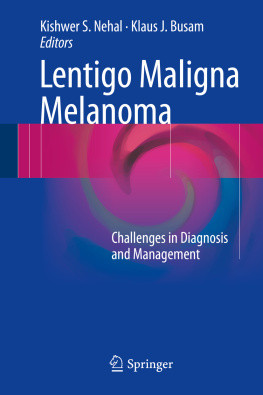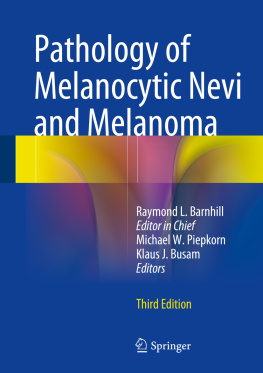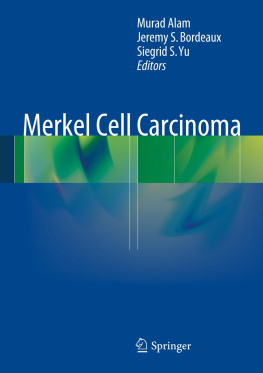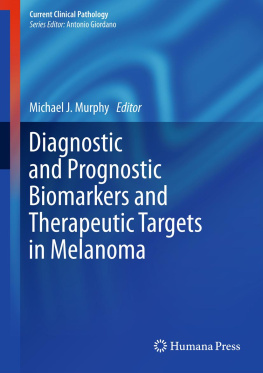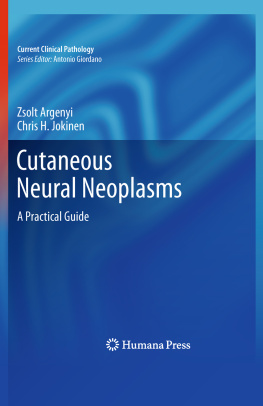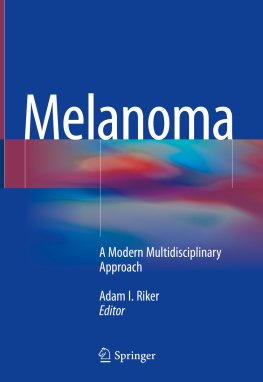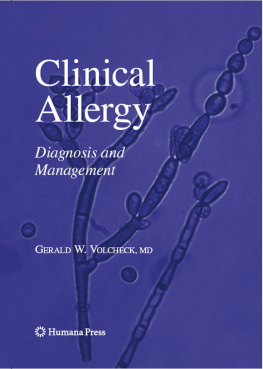1. Introduction
We are privileged to present Lentigo Maligna Melanoma: Challenges in Diagnosis and Management , the first authoritative, comprehensive text focusing solely on this often misunderstood skin cancer. Of the main subtypes of melanoma including superficial spreading, nodular, and acral lentiginous, lentigo maligna (LM) has been at the center of discussion and debate in recent years with confusion and misconceptions surrounding this entity. First described by Hutchinson as Hutchinsons melanotic freckle, LM was considered an infectious process in the late nineteenth century. Two centuries later, misconceptions regarding LM persist, with some still considering this lesion premalignant. LM is recognized by the American Joint Committee on Cancer as a form of melanoma in situ, with lentigo maligna melanoma (LMM) referring to its invasive counterpart. LM must be taken seriously, as potential evolution to a deeply invasive LMM can lead to metastasis and death. For these reasons, a comprehensive text on LM is a necessary and timely contribution. The purpose of this text is to clarify misconceptions and describe the latest techniques used by experts for diagnosis and management of LM and LMM.
In this book we explore the entire spectrum of LM and LMM through the expertise of leaders in the field. First, we will define the extent of the problem by examining the latest data on epidemiology and natural history. Unique characteristics of LM distinguishing it from other melanoma subtypes are outlined, emphasizing that LM must be considered a distinct entity with specific clinical and pathologic features that impact treatment. Challenges in the clinical diagnosis of LM are frequent given its often subtle appearance. We will evaluate utilization of established and more novel technologies such as dermoscopy and reflectance confocal microscopy to aid in the diagnosis of LM. LM is also known to present a challenge histologically, given its development on severely sun-damaged skin which mimics the trailing edge of the malignancy itself.
LM and LMM often present as large lesions involving cosmetically and functionally important facial structures including the eyelid, which necessitates careful consideration of the treatment approach. Specialized techniques for surgical management including staged excision and Mohs micrographic surgery are explored along with unique pathology dilemmas when evaluating LM surgical specimens. Experienced authors who use the various surgical techniques share their expertise and critical assessment of advantages and limitations of each approach which continues to be hotly debated within the dermatologic surgery field. Furthermore, important considerations for challenging facial reconstruction following surgical removal of LM are evaluated.
The shared decision-making process and quality of life for patients with LM and LMM has received increased attention of late, given an emphasis on patient-centered care. In this context, alternative treatments to surgery such as radiation have become a part of the patient discussion. The advent of newer therapeutic options with topical treatments also offers exciting possibilities for nonsurgical management. Finally, special issues unique to the follow-up of LM including characteristics of locally recurrent disease are examined. This text concludes with case studies of LM and LMM that illustrate many of the complexities and challenges that present in a clinical practice.
From pathophysiology and risk factors to optimizing technology for diagnosis, to the latest treatment modalities, LM management requires a comprehensive and thoughtful approach. We trust that the knowledge, insight, and expertise shared by our experienced authors will benefit clinicians at all levels of practice. With the prime demographic of the elderly increasing in number worldwide, the expected incidence of LM and LMM continues to increase. It is therefore essential that dermatologists, pathologists, plastic surgeons, head and neck surgeons, surgical oncologists, ophthalmologists, radiation oncologists, and primary care physicians have a thorough understanding of this disease process. The authors sincerely hope that this LM text providing a comprehensive approach to the diagnostic and management dilemmas will optimize the care of all our patients.
2. Epidemiology and Natural History
Introduction
Originally, some viewed lentigo maligna (LM) as a form of melanoma in situ (MIS); others viewed it as a form of melanocytic dysplasia, yet others as a hybrid category []. Since then, LM has been re-categorized as a subtype of MIS occurring on chronically sun-damaged skin. It has the potential to progress from an in situ tumor to an invasive tumor, known as lentigo maligna melanoma (LMM).
Lentigo malignas are recognized by the World Health Organization and the Surveillance, Epidemiology, and End Results Program as a type of MIS. However, there are some clinicians and scientists who advocate that LM actually embodies a distinct histologic entity compared to MIS []. This chapter will specifically address the epidemiology and characteristics of lentigo maligna and lentigo maligna melanoma.
Incidence
Globally, LM and LMM are thought to account for 415 % of all melanomas. Because they most commonly presents on the head and neck areas, it makes up an even higher proportion of head and neck melanomas, approximately 1026 % [].
Lentigo maligna is typically found on sun-exposed skin, with cumulative UV exposure serving as a known risk factor for development of this malignancy. As such, populations living in southern latitudes compared to northern latitudes tend to have a higher incidence of LM. In Australia, the incidence is estimated at 1.3 cases/100,000 person-years []. This may be a reflection of the high population of individuals living in that area with fair Fitzpatrick skin types.
The mean age of presentation for LM/LMM is 6672 years. Comparatively, the mean age of presentation of non-lentigo maligna melanoma is 4557 years [].
The reported incidence of LM may be influenced by several factors, namely the substantial variation in extent of skin examinations between providers, with increased likelihood of skin examination of sun exposed skin compared to non-sun exposed skin, and the role of attention to facial appearance awareness. Incidence is also difficult to interpret, as some lesions are not visible and detected only incidentally. Furthermore, the ambiguity of definition of the lesion leads some pathologists to report LM as MIS and others to report them as LM.

